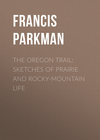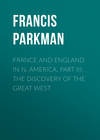Czytaj książkę: «France and England in N America, Part VII, Vol 1: A Half-Century of Conflict», strona 11
CHAPTER X
1713-1724
SEBASTIEN RALE
Boundary Disputes.—Outposts of Canada.—The Earlier and Later Jesuits.—Religion and Politics.—The Norridgewocks and their Missionary.—A Hollow Peace.—Disputed Land Claims.—Council at Georgetown.—Attitude of Rale.—Minister and Jesuit.—The Indians waver.—An Outbreak.—Covert War.—Indignation against Rale.—War declared.—Governor and Assembly.—Speech of Samuel Sewall.—Penobscots attack Fort St. George.—Reprisal.—Attack on Norridgewock.—Death of Rale.
Before the Treaty of Utrecht, the present Nova Scotia, New Brunswick, and a part of Maine were collectively called Acadia by the French; but after the treaty gave Acadia to England, they insisted that the name meant only Nova Scotia. The English on their part claimed that the cession of Acadia made them owners, not only of the Nova Scotian peninsula, but of all the country north of it to the St. Lawrence, or at least to the dividing ridge or height of land.
This and other disputed questions of boundary were to be settled by commissioners of the two powers; but their meeting was put off for forty years, and then their discussions ended in the Seven Years' War. The claims of the rival nations were in fact so discordant that any attempt to reconcile them must needs produce a fresh quarrel. The treaty had left a choice of evils. To discuss the boundary question meant to renew the war; to leave it unsettled was a source of constant irritation; and while delay staved off a great war, it quickly produced a small one.
The river Kennebec, which was generally admitted by the French to be the dividing line between their possessions and New England,228 was regarded by them with the most watchful jealousy. Its headwaters approached those of the Canadian river Chaudière, the mouth of which is near Quebec; and by ascending the former stream and crossing to the headwaters of the latter, through an intricacy of forests, hills, ponds, and marshes, it was possible for a small band of hardy men, unencumbered by cannon, to reach the Canadian capital,—as was done long after by the followers of Benedict Arnold. Hence it was thought a matter of the last importance to close the Kennebec against such an attempt. The Norridgewock band of the Abenakis, who lived on the banks of that river, were used to serve this purpose and to form a sort of advance-guard to the French colony, while other kindred bands on the Penobscot, the St. Croix, and the St. John were expected to aid in opposing a living barrier to English intrusion. Missionaries were stationed among all these Indians to keep them true to Church and King. The most important station, that of the Norridgewocks, was in charge of Father Sebastien Rale, the most conspicuous and interesting figure among the later French-American Jesuits.
Since the middle of the seventeenth century a change had come over the Jesuit missions of New France. Nothing is more striking or more admirable than the self-devoted apostleship of the earlier period.229 The movement in Western Europe known as the Renaissance was far more than a revival of arts and letters,—it was an awakening of intellectual, moral, and religious life; the offspring of causes long in action, and the parent of other movements in action to this day. The Protestant Reformation was a part of it. That revolt against Rome produced a counter Renaissance in the bosom of the ancient Church herself. In presence of that peril she woke from sloth and corruption, and girded herself to beat back the invading heresies, by force or by craft, by inquisitorial fires, by the arms of princely and imperial allies, and by the self-sacrificing enthusiasm of her saints and martyrs. That time of danger produced the exalted zeal of Xavier and the intense, thoughtful, organizing zeal of Loyola. After a century had passed, the flame still burned, and it never shone with a purer or brighter radiance than in the early missions of New France.
Such ardors cannot be permanent; they must subside, from the law of their nature. If the great Western mission had been a success, the enthusiasm of its founders might have maintained itself for some time longer; but that mission was extinguished in blood. Its martyrs died in vain, and the burning faith that had created it was rudely tried. Canada ceased to be a mission. The civil and military powers grew strong, and the Church no longer ruled with undivided sway. The times changed, and the men changed with them. It is a characteristic of the Jesuit Order, and one of the sources of its strength, that it chooses the workman for his work, studies the qualities of its members, and gives to each the task for which he is fitted best. When its aim was to convert savage hordes and build up another Paraguay in the Northern wilderness, it sent a Jogues, a Brébeuf, a Charles Garnier, and a Gabriel Lalemant, like a forlorn hope, to storm the stronghold of heathendom. In later times it sent other men to meet other needs and accomplish other purposes.
Before the end of the seventeenth century the functions of the Canadian Jesuit had become as much political as religious; but if the fires of his apostolic zeal burned less high, his devotion to the Order in which he had merged his personality was as intense as before. While in constant friction with the civil and military powers, he tried to make himself necessary to them, and in good measure he succeeded. Nobody was so able to manage the Indian tribes and keep them in the interest of France. "Religion," says Charlevoix, "is the chief bond by which the savages are attached to us;" and it was the Jesuit above all others who was charged to keep this bond firm.
The Christianity that was made to serve this useful end did not strike a deep root. While humanity is in the savage state, it can only be Christianized on the surface; and the convert of the Jesuits remained a savage still. They did not even try to civilize him. They taught him to repeat a catechism which he could not understand, and practise rites of which the spiritual significance was incomprehensible to him. He saw the symbols of his new faith in much the same light as the superstitions that had once enchained him. To his eyes the crucifix was a fetich of surpassing power, and the mass a beneficent "medicine," or occult influence, of supreme efficacy. Yet he would not forget his old rooted beliefs, and it needed the constant presence of the missionary to prevent him from returning to them.
Since the Iroquois had ceased to be a danger to Canada, the active alliance of the Western Indians had become less important to the colony. Hence the missions among them had received less attention, and most of these tribes had relapsed into heathenism. The chief danger had shifted eastward, and was, or was supposed to be, in the direction of New England. Therefore the Eastern missions were cultivated with diligence,—whether those within or adjoining the settled limits of Canada, like the Iroquois mission of Caughnawaga, the Abenaki missions of St. Francis and Becancour, and the Huron mission of Lorette, or those that served as outposts and advance-guards of the colony, like the Norridgewock Abenakis of the Kennebec, or the Penobscot Abenakis of the Penobscot. The priests at all these stations were in close correspondence with the government, to which their influence over their converts was invaluable. In the wilderness dens of the Hurons or the Iroquois, the early Jesuit was a marvel of self-sacrificing zeal; his successor, half missionary and half agent of the King, had thought for this world as well as the next.
Sebastien Rale,230 born in Franche-Comté in 1657, was sent to the American missions in 1689 at the age of thirty-two. After spending two years among the Abenakis of Canada, then settled near the mouth of the Chaudière, he was sent for two years more to the Illinois, and thence to the Abenakis of the Kennebec, where he was to end his days.
Near where the town of Norridgewock now stands, the Kennebec curved round a broad tongue of meadow land, in the midst of a picturesque wilderness of hills and forests. On this tongue of land, on ground a few feet above the general level, stood the village of the Norridgewocks, fenced with a stockade of round logs nine feet high. The enclosure was square; each of its four sides measured one hundred and sixty feet, and each had its gate. From the four gates ran two streets, or lanes, which crossed each other in the middle of the village. There were twenty-six Indian houses, or cabins, within the stockade, described as "built much after the English manner," though probably of logs. The church was outside the enclosure, about twenty paces from the east gate.231
Such was the mission village of Norridgewock in 1716. It had risen from its ashes since Colonel Hilton destroyed it in 1705, and the church had been rebuilt by New England workmen hired for the purpose.232 A small bell, which is still preserved at Brunswick, rang for mass at early morning, and for vespers at sunset. Rale's leisure hours were few. He preached, exhorted, catechised the young converts, counselled their seniors for this world and the next, nursed them in sickness, composed their quarrels, tilled his own garden, cut his own firewood, cooked his own food, which was of Indian corn, or, at a pinch, of roots and acorns, worked at his Abenaki vocabulary, and, being expert at handicraft, made ornaments for the church, or moulded candles from the fruit of the bayberry, or wax-myrtle.233 Twice a year, summer and winter, he followed his flock to the sea-shore and the islands, where they lived at their ease on fish and seals, clams, oysters, and seafowl.
This Kennebec mission had been begun more than half a century before; yet the conjurers, or "medicine men,"—natural enemies of the missionary,—still remained obdurate and looked on the father askance, though the body of the tribe were constant at mass and confession, and regarded him with loving reverence. He always attended their councils, and, as he tells us, his advice always prevailed; but he was less fortunate when he told them to practise no needless cruelty in their wars, on which point they were often disobedient children.234
Rale was of a strong, enduring frame, and a keen, vehement, caustic spirit. He had the gift of tongues, and was as familiar with the Abenaki and several other Indian languages as he was with Latin.235 Of the genuineness of his zeal there is no doubt, nor of his earnest and lively interest in the fortunes of the wilderness flock of which he was the shepherd for half his life. The situation was critical for them and for him. The English settlements were but a short distance below, while those of the French could be reached only by a hard journey of twelve or fourteen days.
With two intervals of uneasy peace, the borders of Maine had been harried by war-parties for thirty-eight years; and since 1689 these raids had been prompted and aided by the French. Thus it happened that extensive tracts, which before Philip's War were dotted with farmhouses and fishing hamlets, had been abandoned, and cultivated fields were turning again to forests. The village of Wells had become the eastern frontier. But now the Treaty of Utrecht gave promise of lasting tranquillity. The Abenakis, hearing that they were to be backed no longer by the French, became alarmed, sent messengers to Casco, and asked for peace. In July there was a convention at Portsmouth, when delegates of the Norridgewocks, Penobscots, Malicites, and other Abenaki bands met Governor Dudley and the councillors of Massachusetts and New Hampshire. A paper was read to them by sworn interpreters, in which they confessed that they had broken former treaties, begged pardon for "past rebellions, hostilities, and violations of promises," declared themselves subjects of Queen Anne, pledged firm friendship with the English, and promised them that they might re-enter without molestation on all their former possessions. Eight of the principal Abenaki chiefs signed this document with their totemic marks, and the rest did so, after similar interpretation, at another convention in the next year.236 Indians when in trouble can waive their pride, and lavish professions and promises; but when they called themselves subjects of Queen Anne, it is safe to say that they did not know what the words meant.
Peace with the Indians was no sooner concluded than a stream of settlers began to move eastward to reoccupy the lands that they owned or claimed in the region of the lower Kennebec. Much of this country was held in extensive tracts, under old grants of the last century, and the proprietors offered great inducements to attract emigrants. The government of Massachusetts, though impoverished by three wars, of which it had borne the chief burden, added what encouragements it could. The hamlets of Saco, Scarborough, Falmouth, and Georgetown rose from their ashes; mills were built on the streams, old farms were retilled, and new ones cleared. A certain Dr. Noyes, who had established a sturgeon fishery on the Kennebec, built at his own charge a stone fort at Cushnoc, or Augusta; and it is said that as early as 1714 a blockhouse was built many miles above, near the mouth of the Sebasticook.237 In the next year Fort George was built at the lower falls of the Androscoggin, and some years later Fort Richmond, on the Kennebec, at the site of the present town of Richmond.238
Some of the claims to these Kennebec lands were based on old Crown patents, some on mere prescription, some on Indian titles, good or bad. Rale says that an Englishman would give an Indian a bottle of rum, and get from him in return a large tract of land.239 Something like this may have happened; though in other cases the titles were as good as Indian titles usually are, the deeds being in regular form and signed by the principal chiefs for a consideration which they thought sufficient. The lands of Indians, however, are owned, so far as owned at all, by the whole community; and in the case of the Algonquin tribes the chiefs had no real authority to alienate them without the consent of the tribesmen. Even supposing this consent to have been given, the Norridgewocks would not have been satisfied; for Rale taught them that they could not part with their lands, because they held them in trust for their children, to whom their country belonged as much as to themselves.
Long years of war and mutual wrong had embittered the Norridgewocks against their English neighbors, with whom, nevertheless, they wished to be at peace, because they feared them, and because their trade was necessary to them.
The English borderers, on their part, regarded the Indians less as men than as vicious and dangerous wild animals. In fact, the benevolent and philanthropic view of the American savage is for those who are beyond his reach: it has never yet been held by any whose wives and children have lived in danger of his scalping-knife. In Boston and other of the older and safer settlements, the Indians had found devoted friends before Philip's War; and even now they had apologists and defenders, prominent among whom was that relic of antique Puritanism, old Samuel Sewall, who was as conscientious and humane as he was prosy, narrow, and sometimes absurd, and whose benevolence towards the former owners of the soil was trebly reinforced by his notion that they were descendants of the ten lost tribes of Israel.240
The intrusion of settlers, and the building of forts and blockhouses on lands which they still called their own, irritated and alarmed the Norridgewocks, and their growing resentment was fomented by Rale, both because he shared it himself, and because he was prompted by Vaudreuil. Yet, dreading another war with the English, the Indians kept quiet for a year or two, till at length the more reckless among them began to threaten and pilfer the settlers.
In 1716 Colonel Samuel Shute came out to succeed Dudley as governor; and in the next summer he called the Indians to a council at Georgetown, a settlement on Arrowsick Island, at the mouth of the Kennebec. Thither he went in the frigate "Squirrel," with the councillors of Massachusetts and New Hampshire; while the deputies of the Norridgewocks, Penobscots, Pequawkets, or Abenakis of the Saco, and Assagunticooks, or Abenakis of the Androscoggin, came in canoes to meet him, and set up their wigwams on a neighboring island. The council opened on the ninth of August, under a large tent, over which waved the British flag. The oath was administered to the interpreters by the aged Judge Sewall, and Shute then made the Indians a speech in which he told them that the English and they were subjects of the great, good, and wise King George; that as both peoples were under the same King, he would gladly see them also of the same religion, since it was the only true one; and to this end he gave them a Bible and a minister to teach them,—pointing to Rev. Joseph Baxter, who stood near by. And he further assured them that if any wrong should be done them, he would set it right. He then condescended to give his hand to the chiefs, telling them, through the interpreter, that it was to show his affection.
The Indians, after their usual custom, deferred their answer to the next day, when the council again met, and the Norridgewock chief, Wiwurna, addressed the governor as spokesman for his people. In defiance of every Indian idea of propriety, Shute soon began to interrupt him with questions and remarks. Wiwurna remonstrated civilly; but Shute continued his interruptions, and the speech turned to a dialogue, which may be abridged thus, Shute always addressing himself, not to the Indian orator, but to the interpreter.
The orator expressed satisfaction at the arrival of the governor, and hoped that peace and friendship would now prevail.
Governor (to the interpreter). Tell them that if they behave themselves, I shall use them kindly.
Orator (as rendered by the interpreter). Your Excellency was pleased to say that we must obey King George. We will if we like his way of treating us.
Governor. They must obey him.
Orator. We will if we are not disturbed on our lands.
Governor. Nor must they disturb the English on theirs.
Orator. We are pleased that your Excellency is ready to hear our complaints when wrong is done us.
Governor. They must not pretend to lands that belong to the English.
Orator. We beg leave to go on in order with our answer.
Governor. Tell him to go on.
Orator. If there should be any quarrel and bloodshed, we will not avenge ourselves, but apply to your Excellency. We will embrace in our bosoms the English that have come to settle on our land.
Governor. They must not call it their land, for the English have bought it of them and their ancestors.
Orator. We pray leave to proceed with our answer, and talk about the land afterwards.
Wiwurna, then, with much civility, begged to be excused from receiving the Bible and the minister, and ended by wishing the governor good wind and weather for his homeward voyage.
There was another meeting in the afternoon, in which the orator declared that his people were willing that the English should settle on the west side of the Kennebec as far up the river as a certain mill; on which the governor said to the interpreter: "Tell them we want nothing but our own, and that that we will have;" and he ordered an old deed of sale, signed by six of their chiefs, to be shown and explained to them. Wiwurna returned that though his tribe were uneasy about their lands, they were willing that the English should keep what they had got, excepting the forts. On this point there was a sharp dialogue, and Shute said bluntly that if he saw fit, he should build a fort at every new settlement. At this all the Indians rose abruptly and went back to their camp, leaving behind an English flag that had been given them.
Rale was at the Indian camp, and some of them came back in the evening with a letter from him, in which he told Shute that the governor of Canada had asked the King of France whether he had ever given the Indians' land to the English, to which the King replied that he had not, and would help the Indians to repel any encroachment upon them. This cool assumption on the part of France of paramount right to the Abenaki country incensed Shute, who rejected the letter with contempt.
As between the governor and the Indian orator, the savage had shown himself by far the more mannerly; yet so unwilling were the Indians to break with the English that on the next morning, seeing Shute about to re-embark, they sent messengers to him to apologize for what they called their rudeness, beg that the English flag might be returned to them, and ask for another interview, saying that they would appoint another spokesman instead of Wiwurna, who had given so much offence. Shute consented, and the meeting was held. The new orator presented a wampum belt, expressed a wish for peace, and said that his people wished the English to extend their settlements as far as they had formerly done. Shute, on his part, promised that trading-houses should be established for supplying their needs, and that they should have a smith to mend their guns, and an interpreter of their own choice. Twenty chiefs and elders then affixed their totemic marks to a paper, renewing the pledges made four years before at Portsmouth, and the meeting closed with a dance in honor of the governor.241
The Indians, as we have seen, had shown no eagerness to accept the ministrations of Rev. Joseph Baxter. The Massachusetts Assembly had absurdly tried to counteract the influence of Rale by offering £150 a year in their depreciated currency to any one of their ministers who would teach Calvinism to the Indians. Baxter, whom Rale, with characteristic exaggeration, calls the ablest of the Boston ministers, but who was far from being so, as he was the pastor of the small country village of Medfield, took up the task, and, with no experience of Indian life or knowledge of any Indian language, entered the lists against an adversary who had spent half his days among savages, had gained the love and admiration of the Norridgewocks, and spoke their language fluently. Baxter, with the confidence of a novice, got an interpreter and began to preach, exhort, and launch sarcasms against the doctrines and practices of the Roman Church. Rale excommunicated such of his flock as listened to him;242 yet some persisted in doing so, and three of these petitioned the English governor to order "a small praying-house" to be built for their use.243
Rale, greatly exasperated, opened a correspondence with Baxter, and wrote a treatise for his benefit, in which, through a hundred pages of polemical Latin, he proved that the Church of Rome was founded on a rock. This he sent to Baxter, and challenged him to overthrow his reasons. Baxter sent an answer for which Rale expresses great scorn as to both manner and matter. He made a rejoinder, directed not only against his opponent's arguments, but against his Latin, in which he picked flaws with great apparent satisfaction. He says that he heard no more from Baxter for a long time, but at last got another letter, in which there was nothing to the purpose, the minister merely charging him with an irascible and censorious spirit. This letter is still preserved, and it does not answer to Rale's account of it. Baxter replies to his correspondent vigorously, defends his own Latin, attacks that of Rale, and charges him with losing temper.244
Rale's correspondence with the New England ministers seems not to have been confined to Baxter. A paper is preserved, translated apparently from a Latin original, and entitled, "Remarks out of the Fryar Sebastian Rale's Letter from Norridgewock, February 7, 1720." This letter appears to have been addressed to some Boston minister, and is of a scornful and defiant character, using language ill fitted to conciliate, as thus: "You must know that a missionary is not a cipher, like a minister;" or thus: "A Jesuit is not a Baxter or a Boston minister." The tone is one of exasperation dashed with contempt, and the chief theme is English encroachment and the inalienability of Indian lands.245 Rale says that Baxter gave up his mission after receiving the treatise on the infallible supremacy of the true Church; but this is a mistake, as the minister made three successive visits to the Eastern country before he tired of his hopeless mission.
In the letter just quoted, Rale seems to have done his best to rasp the temper of his New England correspondent. He boasts of his power over the Indians, who, as he declares, always do as he advises them. "Any treaty with the governor," he goes on to say, "and especially that of Arrowsick, is null and void if I do not approve it, for I give them so many reasons against it that they absolutely condemn what they have done." He says further that if they do not drive the English from the Kennebec, he will leave them, and that they will then lose both their lands and their souls; and he adds that, if necessary, he will tell them that they may make war.246 Rale wrote also to Shute; and though the letter is lost, the governor's answer shows that it was sufficiently aggressive.
The wild Indian is unstable as water. At Arrowsick, the Norridgewocks were all for peace; but when they returned to their village their mood changed, and, on the representations of Rale, they began to kill the cattle of the English settlers on the river below, burn their haystacks, and otherwise annoy them.247 The English suspected that the Jesuit was the source of their trouble; and as they had always regarded the lands in question as theirs, by virtue of the charter of the Plymouth Company in 1620, and the various grants under it, as well as by purchase from the Indians, their ire against him burned high. Yet afraid as the Indians were of another war, even Rale could scarcely have stirred them to violence but for the indignities put upon them by Indian-hating ruffians of the border, vicious rum-selling traders, and hungry land-thieves. They had still another cause of complaint. Shute had promised to build trading-houses where their wants should be supplied without fraud and extortion; but he had not kept his word, and could not keep it, for reasons that will soon appear.
In spite of such provocations, Norridgewock was divided in opinion. Not only were the Indians in great dread of war, but they had received English presents to a considerable amount, chiefly from private persons interested in keeping them quiet. Hence, to Rale's great chagrin, there was an English party in the village so strong that when the English authorities demanded reparation for the mischief done to the settlers, the Norridgewocks promised two hundred beaver-skins as damages, and gave four hostages as security that they would pay for misdeeds in the past, and commit no more in the future.248
Rale now feared that his Indians would all go over to the English and tamely do their bidding; for though most of them, when he was present, would denounce the heretics and boast of the brave deeds they would do against them, yet after a meeting with English officials, they would change their minds and accuse their spiritual father of lying. It was clear that something must be done to end these waverings, lest the lands in dispute should be lost to France forever.
The Norridgewocks had been invited to another interview with the English at Georgetown; and Rale resolved, in modern American phrase, to "capture the meeting." Vaudreuil and the Jesuit La Chasse, superior of the mission, lent their aid. Messengers were sent to the converted Indians of Canada, whose attachment to France and the Church was past all doubt, and who had been taught to abhor the English as children of the Devil. The object of the message was to induce them to go to the meeting at Georgetown armed and equipped for any contingency.
They went accordingly,—Abenakis from Becancour and St. Francis, Hurons from Lorette, and Iroquois from Caughnawaga, besides others, all stanch foes of heresy and England. Rale and La Chasse directed their movements and led them first to Norridgewock, where their arrival made a revolution. The peace party changed color like a chameleon, and was all for war. The united bands, two hundred and fifty warriors in all, paddled down the Kennebec along with the two Jesuits and two French officers, Saint-Castin and Croisil. In a few days the English at Georgetown saw them parading before the fort, well armed, displaying French flags,—feathers dangling from their scalp-locks, and faces fantastically patterned in vermilion, ochre, white clay, soot, and such other pigments as they could find or buy.
They were met by Captain Penhallow and other militia officers of the fort, to whom they gave the promised two hundred beaver-skins, and demanded the four hostages in return; but the hostages had been given as security, not only for the beaver-skins, but also for the future good behavior of the Indians, and Penhallow replied that he had no authority to surrender them. On this they gave him a letter to the governor, written for them by Père de la Chasse, and signed by their totems. It summoned the English to leave the country at once, and threatened to rob and burn their houses in case of refusal.249 The threat was not executed, and they presently disappeared, but returned in September in increased numbers, burned twenty-six houses and attacked the fort, in which the inhabitants had sought refuge. The garrison consisted of forty men, who, being reinforced by the timely arrival of several whale-boats bringing thirty more, made a sortie. A skirmish followed; but being outnumbered and outflanked, the English fell back behind their defences.250
The French authorities were in a difficult position. They thought it necessary to stop the progress of English settlement along the Kennebec; and yet, as there was peace between the two Crowns, they could not use open force. There was nothing for it but to set on the Abenakis to fight for them. "I am well pleased," wrote Vaudreuil to Rale, "that you and Père de la Chasse have prompted the Indians to treat the English as they have done. My orders are to let them want for nothing, and I send them plenty of ammunition." Rale says that the King allowed him a pension of six thousand livres a year, and that he spent it all "in good works." As his statements are not remarkable for precision, this may mean that he was charged with distributing the six thousand livres which the King gave every year in equal shares to the three Abenaki missions of Medoctec, Norridgewock, and Panawamské, or Penobscot, and which generally took the form of presents of arms, gunpowder, bullets, and other munitions of war, or of food and clothing to support the squaws and children while the warriors were making raids on the English.251



















